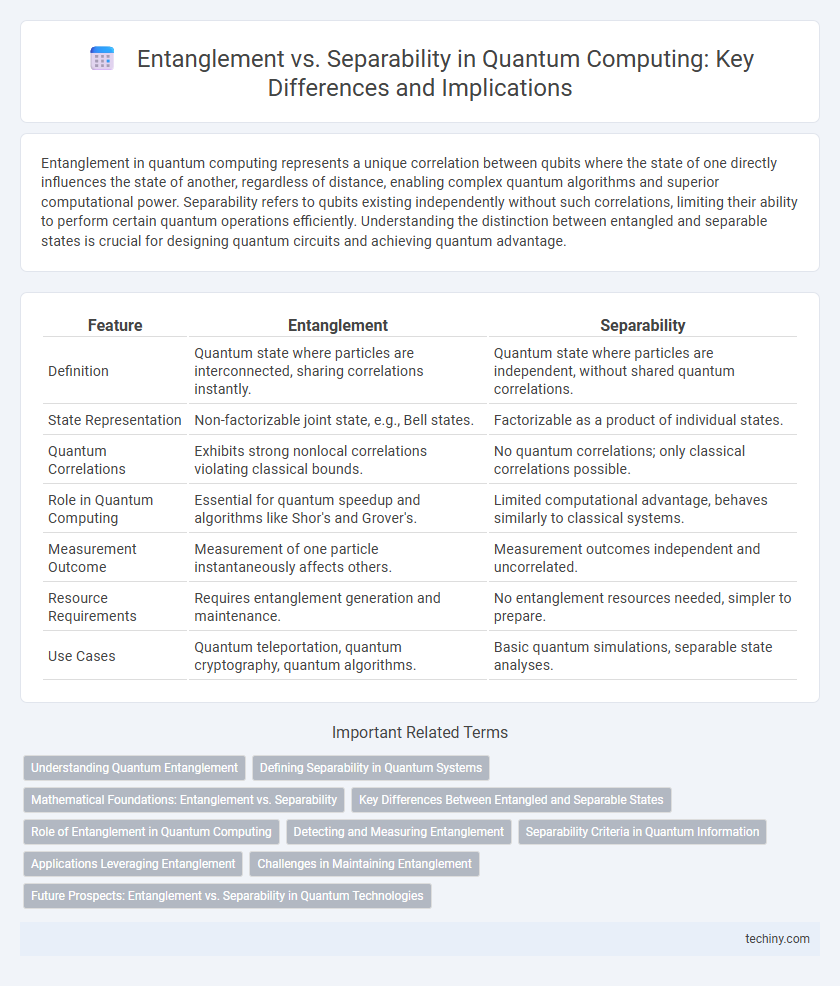Entanglement in quantum computing represents a unique correlation between qubits where the state of one directly influences the state of another, regardless of distance, enabling complex quantum algorithms and superior computational power. Separability refers to qubits existing independently without such correlations, limiting their ability to perform certain quantum operations efficiently. Understanding the distinction between entangled and separable states is crucial for designing quantum circuits and achieving quantum advantage.
Table of Comparison
| Feature | Entanglement | Separability |
|---|---|---|
| Definition | Quantum state where particles are interconnected, sharing correlations instantly. | Quantum state where particles are independent, without shared quantum correlations. |
| State Representation | Non-factorizable joint state, e.g., Bell states. | Factorizable as a product of individual states. |
| Quantum Correlations | Exhibits strong nonlocal correlations violating classical bounds. | No quantum correlations; only classical correlations possible. |
| Role in Quantum Computing | Essential for quantum speedup and algorithms like Shor's and Grover's. | Limited computational advantage, behaves similarly to classical systems. |
| Measurement Outcome | Measurement of one particle instantaneously affects others. | Measurement outcomes independent and uncorrelated. |
| Resource Requirements | Requires entanglement generation and maintenance. | No entanglement resources needed, simpler to prepare. |
| Use Cases | Quantum teleportation, quantum cryptography, quantum algorithms. | Basic quantum simulations, separable state analyses. |
Understanding Quantum Entanglement
Quantum entanglement describes a phenomenon where particles become interconnected so that the state of one instantly influences the state of another, regardless of distance. This contrasts with separability, where the overall state of a system can be expressed as a simple combination of individual particle states without interdependence. Understanding quantum entanglement is crucial for advancing quantum communication, cryptography, and computing, as it enables correlations that classical systems cannot achieve.
Defining Separability in Quantum Systems
Separability in quantum systems refers to the ability to express the overall state as a tensor product of individual subsystem states, indicating no entanglement between them. A separable state can be represented as a mixture of product states, signaling the absence of quantum correlations. This concept is critical for distinguishing classical correlations from genuinely quantum entangled states in quantum information theory.
Mathematical Foundations: Entanglement vs. Separability
Entanglement and separability in quantum computing are rigorously defined through the mathematical formalism of density matrices and tensor product spaces. A quantum state is separable if it can be expressed as a convex combination of product states, meaning its density matrix decomposes into a sum of tensor products of subsystem states. Conversely, entangled states cannot be represented by such a decomposition, reflecting non-classical correlations that violate classical probabilistic separability conditions fundamental to quantum information theory.
Key Differences Between Entangled and Separable States
Entangled states exhibit non-local correlations that cannot be explained by classical physics, enabling quantum information processing tasks like superdense coding and quantum teleportation. Separable states lack these quantum correlations and can be represented as a mixture of product states, making them classically simulable. The key difference lies in the presence of inseparable quantum correlations in entangled states versus the factorability of separable states, impacting computational advantage in quantum algorithms.
Role of Entanglement in Quantum Computing
Entanglement serves as a fundamental resource in quantum computing, enabling qubits to exhibit correlations that classical bits cannot achieve, which enhances computational power and speed. This non-local correlation allows for more efficient algorithms in tasks like factoring large numbers and searching unsorted databases, surpassing classical limitations. The presence of entanglement is crucial for quantum error correction and secure quantum communication, underpinning advancements in quantum supremacy.
Detecting and Measuring Entanglement
Detecting and measuring entanglement involves quantitative techniques such as entanglement witnesses, concurrence, and negativity, which provide scalar values indicating the presence and degree of entanglement between quantum states. Separability criteria, like the Positive Partial Transpose (PPT) test and Peres-Horodecki criterion, help distinguish separable (classically correlated) states from entangled states by analyzing the density matrix of composite systems. Advanced methods include quantum state tomography and machine learning algorithms to accurately characterize entanglement in multi-qubit systems, crucial for optimizing quantum computing performance.
Separability Criteria in Quantum Information
Separability criteria in quantum information theory are essential for distinguishing entangled states from separable states, which can be expressed as a convex combination of product states. The Positive Partial Transpose (PPT) criterion, also known as the Peres-Horodecki criterion, is widely used for detecting entanglement in bipartite quantum systems by checking the positivity of the partially transposed density matrix. Other criteria like the computable cross-norm or realignment (CCNR) criterion and entanglement witnesses provide complementary approaches for identifying non-separability in mixed states, aiding in quantum communication and computation tasks.
Applications Leveraging Entanglement
Entanglement enables quantum computers to perform complex computations exponentially faster than classical systems by exploiting non-separable states for parallel processing. Applications leveraging entanglement include quantum cryptography, where entangled particles ensure secure communication protocols such as quantum key distribution (QKD). Quantum sensing and metrology also utilize entanglement to achieve higher precision measurements surpassing classical limits.
Challenges in Maintaining Entanglement
Maintaining entanglement in quantum computing faces significant challenges due to decoherence caused by environmental noise and quantum system imperfections. Quantum entangled states are highly sensitive, making them susceptible to loss of coherence, which directly impacts the reliability and scalability of quantum algorithms. Error correction techniques and isolation strategies are essential to preserve entanglement and ensure stable quantum computations.
Future Prospects: Entanglement vs. Separability in Quantum Technologies
Entanglement remains a cornerstone for advancing quantum technologies, enabling unparalleled capabilities in quantum communication, cryptography, and computing by linking quantum states nonlocally. Future research aims to harness robust entanglement despite environmental decoherence, optimizing scalability and fault tolerance in quantum networks. Separability, while classically intuitive, limits quantum processing power, yet understanding its boundaries helps design error-correcting protocols and hybrid systems blending quantum and classical information.
entanglement vs separability Infographic

 techiny.com
techiny.com